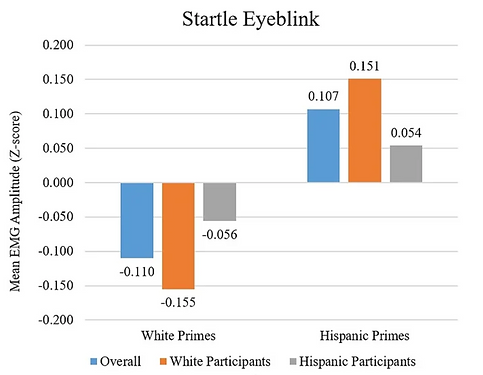

Prejudice & Bias
Exploring Mechanisms Underlying Bias
Distinguishing Threat from Valence as a Source of Bias
The threat-valence distinction described by the DIP model may be particularly relevant for understanding specific group-based prejudices. For example, Black individuals are disproportionate victims of police violence (police are 4, 18, and 3 times more likely to use force on Blacks than Hispanics, Asians, and Whites, respectively). This could merely be due to a stronger dislike of Black individuals relative to members of other racial backgrounds. Alternatively, despite a range of negative stereotypes with which Blacks are associated, this pattern might be primarily due to associations of Black men with physical threat.
We methodologically differentiated threat and negativity in examining anti-black bias to test this. In Studies 1 and 2, positive, negative, and threatening targets (from the above-described image set) were categorized as "good" or "bad" following Black or White face primes in an evaluative priming task. The speed at which people identify a target is directly tied to how related it is to the prime that

came just before it. You can see in the image to the right that, in both studies, participants were faster to evaluate threat but not negative targets following Black versus White primes. This implies that Black specifically primed concepts of threat, but not general negative valence.Studies 3 and 4 used mouse-tracking, which records the x- and y- coordinates as people move the mouse from the bottom of the screen to choose between two target labels located at the top left and right, respectively, of the screen. Here we assessed the relative strength of Black-threat vs. Black-negative associations by pitting threat and non-threat negative response labels within singular trials (see “TICC” under current research for a full explanation of the mouse-tracking analyses). In each study, we measured how quickly people began to correctly categorize each face. The speed at which they categorize the face is a an indication of the strength of the associations between each race and each target. The earlier they turn to the correct target, the stronger is the association. in study 3, participants categorized angry Black faces as threatening
(“Dangerous” response ) more quickly than White or Asian faces. You can see in the figure to the right that the mouse-path turned toward the "Dangerous" label earlier for Black face than for White or Asian faces. Importantly, how quickly they categorized dangerous Black faces was unaffected by negative (“Depressed”), positive (“Happy”) or neutral (“Calm”) distractor labels. Study 4 replicated these findings using different response labels (positive, dangerous, and negative vs. not-positive, not-dangerous, and not-negative). Again, people more more quickly began to categorize the Black faces as Dangerous than they did the White faces, and this categorization was unaffected by a

negative distractor label. These findings demonstrate that Black-threat associations are stronger than Black-negative associations. Last, Study 5 combined the evaluative priming task of Studies 1 and 2 with the simultaneous pairings of threat and negativity of Studies 3 and 4. Participants categorized non-threatening negative (e.g., awful, disliked, inferior) or threatening word targets (e.g., aggressive, harmful, murderous) following typical Black (e.g., Darnell, DeAndre, DeShawn) or White (e.g. Brad, Connor, Ethan) name primes. You see in the figure to the right that participants were faster to categorize threatening words following Black versus White primes yet demonstrated a no difference in their response to negative words after Black and. White primes. These results conceptually replicate the findings of Studies 3 and 4, demonstrating that White
Americans more strongly associate Black men with threat than negativity. Methodologically differentiating threat from valence showed that that White Americans automatically evaluate Black men as survival threats. Critically, this work does not suggest that White Americans lack negative (or positive) stereotypes of Black men but rather that White Americans’ initial (or early automatic) evaluation of Black men is that they pose a survival threat. This distinction holds several

implications for anti-Black prejudice. Indeed, certain instances of anti-Black bias may specifically result from automatic threat evaluations rather than merely reflecting disdain or dislike. If so, interventions aimed at reducing such bias would benefit from particularly addressing threat response or danger associations.
March, D., S. & Gaertner, L., & Olson, M. A. (in press). Danger or dislike: Distinguishing threat from valence as sources of automatic anti-Black bias. Journal of Personality and Social Psychology. PDF Version.
Data and materials available on the Open Science Framework website.
In-group and Out-group Favoritism Towards and Among Hispanics
While outgroup bias is well studied, ingroup bias has received far less attention. I examined ingroup biases among Latino/a individuals and outgroup biases toward Hispanics among White (Caucasian non-Hispanic) individuals using the startle eyeblink paradigm (a measure of defensive responding), the Implicit Association Test (IAT; a measure of good/bad evaluation), and an explicit self-report measure. Here I used Hispanic and White male faces as stimuli during both the startle task and the IAT. A similar pattern of results were observed for both startle and IAT measures: both groups displayed responses indicative of negative attitudes toward Hispanic male faces relative to White male faces, although less so for Hispanic participants. The startle responses indicated a larger defensive response to Hispanic than White male faces. A DIP Model (see above) interpretation of these results suggests that that these measures index different aspects of attitudes and tap into different processes. The IAT measuring the valenced group level association, startle measuring lower-level fear associations.


March, D. S.& Graham, R. (2015). Exploring implicit ingroup and outgroup bias toward Hispanics. Group Processes and Intergroup Relations, 18, 89-103. PDF Version.
Black-Threat Associations among Black Americans
Recent work has shown that good/bad out-group favoritism of Blacks for Whites may reflect positive associations with White more than negative associations with Black. The DIPM suggests that Black Americans may come to associate their own group with threat, even absent a concurrent Black-negative association. Indeed, Individuals raised in the same society likely integrate many of the same associations, regardless of whether the stereotype regards their ingroup. Three studies collecting data from Black participants assessed associations between Black and White with threat, negativity, and threat versus negativity. Study 1 employed mouse-tracking to assess the relative associations between Black versus White males with threat versus negativity. Study 2 used an evaluative priming task to test the relative strengths of the Black versus White, threat versus negative associations by assessing how quickly Black Americans categorize negative or threatening words when preceded by Black or White names. Study 3 used the same Threat and Negative target words and Black and White names used in Study 2 in addition to several words previously piloted to be neutral (general,

indifferent, normal, neutral, regular, or undefined). By separately operationalizing threat versus negativity within measures, I found that Black Americans hold automatic Black-threat associations, perhaps absent concurrent automatic Black-negative associations. This supports the DIPM’s threat versus negativity distinction within the realm of anti-Black bias and supplements recent work by showing that the presence of out-group favoritism on one dimension (i.e., threat) can occur even in the absence of out-group favoritism on a seemingly related but more general dimension (i.e., negativity).
March, D. S. (2023). Perceiving a danger within: Black Americans associate Black men with physical threat. Social Psychological and Personality Science. 14, 942-951.